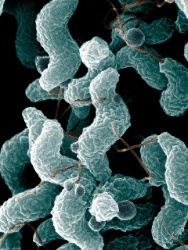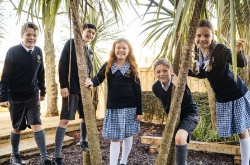Restoration work the focus of Workshop
Media Release
July 7, 2009
Restoration work the focus of Waikato University workshop
Ecological, Maori and legal issues around urban
restoration are on the agenda this week at a Waikato
University workshop.
The three-day workshop, beginning today (SUBS JULY 7), is the culmination of four years of an urban restoration research programme, led by Waikato University researchers. The programme was funded by the Foundation for Research, Science and Technology to the tune of $398,000 a year for four years.
The project aimed to determine the best way to restore natural ecosystems in city areas where development has depleted their biodiversity. It focussed on Hamilton, but project leader, Waikato University’s Professor Bruce Clarkson, says the framework developed is widely applicable to other areas with an emphasis on restoration planting and pest control, backed up by scientific monitoring and assessing whether goals have been achieved.
One of the world’s urban restoration pioneers will speak at the workshop. Professor Rutherford Platt from the University of Massachusetts Amherst will talk about the Humane Metropolis – People and Nature in the 21st Century. Prof Platt says for the first time in the world’s history, more people live in urban than rural areas and the emphasis must now shift from trying to limit urban sprawl, to focusing on making those urban areas as green and habitable as possible.
Prof Clarkson says about 45 people will attend the University of Waikato workshop – mostly from councils around New Zealand keen to know what has been achieved and how it could be applied to their city. “We have been feeding them information about how our restoration work was going. We have established a network of the 25 largest urban centres in New Zealand and they have been getting results put in front of them.”
Waikato University researchers have worked out the indigenous cover in the 20 largest urban areas. New Plymouth is top with 8.5% of indigenous cover in the city area. Dunedin has just 1% and Palmerston North epitomises many New Zealand cities, with virtually no indigenous cover.
The Hamilton basin had only 1.6% of its original natural ecosystem, Prof Clarkson says. “Everybody thought there was nothing that could be done in Hamilton, that it was too far gone. But we have definitely made a significant contribution. Currently about 200ha is in various stages of restoration and the first tuis are being seen.”
Prof Clarkson says aside from the many gully restoration projects in Hamilton, the big success story in the urban restoration project is Horseshoe Lake, or Waiwhakareke near the Hamilton Zoo. Native plantings are being used to reconstruct the original ecosystem, improve the water, and give Hamilton more wildlife corridors. Prof Clarkson says the first plantings were done in 2004 – and already 8.1ha of the 55ha pasture has been replanted.
One part of that has been understanding Maori historical knowledge about Lake Waiwhakareke. The university asked ethnographic researcher Wiremu Puke to identify and document the pre-European Maori ecosystem. Mr Puke, who will also speak at the university workshop, used diaries from Ngati Wairere paramount chief Waharoa Te Puke who described the landform and ecosystems of the Waikato area long before Europeans arrived. Mr Puke also spoke to senior kaumatua of the seven Tainui hapu in the Nga Mana Toopu O Kirikiriroa Trust which was formed to represent and protect the traditional lands in the area Hamilton now covers.
Community support for urban restoration, particularly from local bodies, is invaluable, Prof Clarkson says. “Hamilton City Council has been tremendous. They are completely behind what we are doing, and that’s one of the main reasons this programme has been so successful.”
He says few projects are as interdisciplinary as this one with social, legal, ecological and Maori aspects of urban restoration all being considered. Support has come from researchers at Landcare Research and Environment Waikato.
Other workshop topics covered over the next two days include the social dimensions of urban restoration; a perfect city from an ecologist’s perspective; recreating a rare bog ecosystem; pest mammals and birds around Hamilton; can urban streams be restored?; monitoring restoration planting and legal barriers facing restoration groups.
The University of Waikato workshop runs 8am-5pm July 7 and 8, with a field trip on July 9 which looks at 40 years of restoration projects around Hamilton City.
ends


 Heritage New Zealand: Kakanui Church Listed As Category 1 Historic Place
Heritage New Zealand: Kakanui Church Listed As Category 1 Historic Place NZ College of Public Health Medicine: College Supports Calls For Stronger Regulation To Address Campylobacter Epidemic
NZ College of Public Health Medicine: College Supports Calls For Stronger Regulation To Address Campylobacter Epidemic Ngā Pae o te Māramanga (NPM): Higher Education Improves Outcomes For Māori And Pacific People
Ngā Pae o te Māramanga (NPM): Higher Education Improves Outcomes For Māori And Pacific People The Charter School Agency: Eighth Charter School Opens In Auckland
The Charter School Agency: Eighth Charter School Opens In Auckland Oceania Football Confederation: Change Of Host Nation For OFC Futsal Men's Cup 2025
Oceania Football Confederation: Change Of Host Nation For OFC Futsal Men's Cup 2025 Otago Polytechnic: Otago Polytechnic To Stand Alone But Deep Concerns Over Federation
Otago Polytechnic: Otago Polytechnic To Stand Alone But Deep Concerns Over Federation